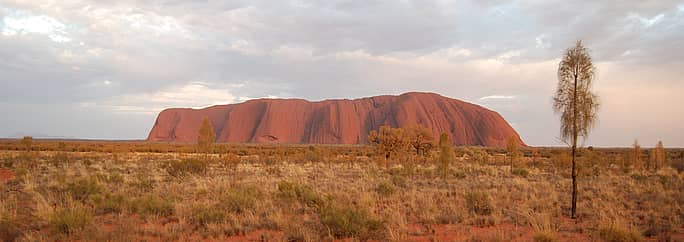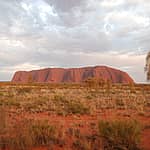In the Uluru-Katja Tjuta National park and listed by the UNESCO, Uluru is a giant purple monolith, 3.6 km long and peaking at 863 metres. The emblem of Australia, Uluru is sacred to the aboriginal Anangu tribe.
My suggestion:
Discover Uluru at sunrise or at sunset from the different points of view created for this purpose. Learn about aboriginal culture at the Uluru-Kata Tjuta cultural centre. Do the Mala Walk. Don't forget the Olga Mountains 30 km from Uluru.
My review
I hesitated a little before deciding to visit Uluru during my trip, for the simple reason that it is situated right in the middle of Australia. However, I realised that the rock and the Olga Mountains were well worth all those kilometres in the flat desert: the closer you get to the monolith, the more the vegetation changes, plunging you in the midst of a painter's palette of colours: red earth, green fields, then yellow fields, followed by red sand and charred black trees. To see the rock you must pay an entry fee at the Uluru-Kata Tjuta National Park. Just outside the park, you will find various means of accommodation in Yulara (20 km from Uluru), which has the monopoly over food and shelter. It is far from being the most beautiful complex in the world, but if you camp, the price remains reasonable and that suited me fine. When you enter the park, you set foot on a land that is sacred to the aboriginal people. To learn more about them, don't miss a tour of the cultural centre, just one kilometre from Uluru. It traces the history of the region and also presents aboriginal art and culture, with the possibility to buy original works.
You first discover Uluru from the road. At the end of the day, it is tinted in shades of dark brown; it strikes a contrast with the yellow grass, and at sunset it turns red! I got up at 4:15 to see it in the morning and the car park of the viewpoint was already crowded. The fireworks begin when the sun touches the horizon! It was difficult to photograph "the rock" without somebody's head in front of my lens. But the tourists left quickly enough (when I was there, there was almost nobody left only 20 minutes after sunrise). I strongly advise you to approach this beautiful rock. If you're up to it, you can walk right round it (Base Walk: 10 km nonetheless!) or you can do as I did and take the Mala Walk: a rather short 2 km circuit (avoid the middle of the afternoon, when the temperatures hit 40 °C). You can take a guide, but the fauna, the flora and the history of the Aborigines are well explained by the panels along the trail and at the cultural centre. You really feel small at the foot of this rocky pachyderm! The slopes are steep in places and more gentle in others. During the walk, you discover caves with rock paintings, valleys, hollows, promontories, and a place to collect water at the foot of the rock. You follow the history of the Aborigines and their traditions as you progress along this marked trail. Certain places of Uluru are sacred and photography is prohibited there. The rock must be magical in the rain, with all the black gullies dug out over time: apparently it transforms into a real fountain.
People used to climb Uluru, which was not only dangerous (steep slopes, violent winds and intense heat), but was also considered as a desecration by the Aborigines and a lack of respect of their traditions. Today, it is still possible to do so in fine weather, even if the centre strongly advises against it (many people have been killed trying to climb it). In the cultural centre, I was even surprised to find a book of forgiveness intended for persons who wish to apologise to the aboriginal community for having climbed the monolith. There is also a book which requests your signature and your name if you are among those who have not climbed it. I came across the story of a Swiss man who apologised for having taken home a stone from Uluru and who had returned to Australia to bring it back. He wrote that at the time he had not realised the importance of this culture.
For a total change of scenery in the heart of the Aborigine territory, don't miss a visit to Uluru during your trip to Australia.
![Travel to Fiji]()









